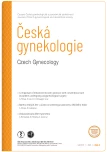Cesarean scar pregnancy – a retrospective analysis of cases in the years 2012–2021
Authors:
J. Hanáček 1,2; Hynek Heřman 1,2; Brandejsová A. 1; Eminger M. 1; P. Křepelka 1; Velebil P. 1,2; Ladislav Krofta 1,2; K. Macková 1
Authors‘ workplace:
Ústav pro péči o matku a dítě, Praha
1; 3. lékařská fakulta UK, Praha
2
Published in:
Ceska Gynekol 2022; 87(4): 245-248
Category:
Original Article
doi:
https://doi.org/10.48095/cccg2022245
Overview
Introduction: With the increasing number of caesarean sections, the number of cesarean scar pregnancies (CSP) is also increasing. This is a relatively new entity of an ectopic pregnancy, which is risky mainly because of its possible association with placenta accreta spectrum. CSP is thought to represent about 6% of the total number of ectopic pregnancies in all women who have a history of at least one caesarean section. The estimated incidence of CSP is about 1/1,688 of all pregnancies and about 1/2,000 of all caesarean sections. Material and methods: Retrospective analysis of individual cases of cesarean scar pregnancies managed in our health care facility in the years 2012–2021. Results: In total, we managed 16 cases of pregnancy in the caesarean scar in 15 women. In one woman, we recorded CSP twice. The mean age of the women was 36.6 years (27–41). The mean number of caesarean sections was 1.6 (1–3) and gestational week was 7 (4–10). The average time since the caesarean section was 3.6 years (2–11). The management was methotrexate administration once, hysteroscopic resection once and 11times primarily vacuum aspiration only, when in two cases we had to attach laparoscopic uterine artery ligation due to postoperative bleeding. We performed primary ligature of uterine arteries twice before performing vacuum aspiration. In pregnancies above 10 weeks of gestation, we observed more bleeding complications requiring surgical management. Bleeding complications were also related to the presence of fetal cardiac action. Conclusion: Early correct diagnosis is essential in the management of CSP. Pregnancies up to the 10th week of gestation are managed by simple vacuum aspirations under ultrasound guidance. If the pregnancy is over the 10th week of gestation and especially with cardiac activity, we add laparoscopic uterine artery ligation before vacuum aspiration. All patients are subsequently advised to undergo laparoscopic resuturing of the lower uterine segment.
Keywords:
Methotrexate – ultrasound – cesarean scar pregnancy – vacuum aspiration – uterine artery ligation
Sources
1. Parker VL, Srinivas M. Non-tubal ectopic pregnancy. Arch Gynecol Obstet 2016; 294 (1): 19–27. doi: 10.1007/s00404-016-4069-y.
2. Ouyang Y, Li X, Yi Y et al. First-trimester diagnosis and management of Cesarean scar pregnancies after in vitro fertilization-embryo transfer: a retrospective clinical analysis of 12 cases. Reprod Biol Endocrinol 2015; 13: 126. doi: 10.1186/s12958-015-0120-2.
3. Timor-Tritsch IE, Monteagudo A, Cali G et al. Cesarean scar pregnancy and early placenta accreta share common histology. Ultrasound Obstet Gynecol 2014; 43 (4): 383–395. doi: 10.1002/ uog.13282.
4. Timor-Tritsch IE, Haynes MC, Monteagudo A et al. Ultrasound diagnosis and management of acquired uterine enhanced myometrial vascularity/arteriovenous malformations. Am J Obstet Gynecol 2016; 214 (6): 731.e1–731.e10. doi: 10.1016/j.ajog.2015.12.024.
5. Calì G, Forlani F, Minneci G et al. First-trimester prediction of surgical outcome in abnormally invasive placenta using the cross-over sign. Ultrasound Obstet Gynecol 2018; 51 (2): 184–188. doi: 10.1002/uog.17440.
6. Calì G, Timor-Trisch IE, Palacios-Jaraquemada J et al. Changes in ultrasonography indicators of abnormally invasive placenta during pregnancy. Int J Gynaecol Obstet 2018; 140 (3): 319–325. doi: 10.1002/ijgo.12 413.
7. Seow KM, Huang LW, Lin MY et al. Cesarean scar pregnancy: issues in management. Ultrasound Obstet Gynecol 2004; 23 (3): 247–253. doi: 10.1002/uog.974.
Labels
Paediatric gynaecology Gynaecology and obstetrics Reproduction medicineArticle was published in
Czech Gynaecology

2022 Issue 4
Most read in this issue
- Uterine perforation during intrauterine procedures and its management
- Uterus sparing surgery in adenomyosis and its impact on reproductive outcomes
- Cesarean scar pregnancy – a retrospective analysis of cases in the years 2012–2021
- Amniotic fluid embolism – review and multicentric case analysis
